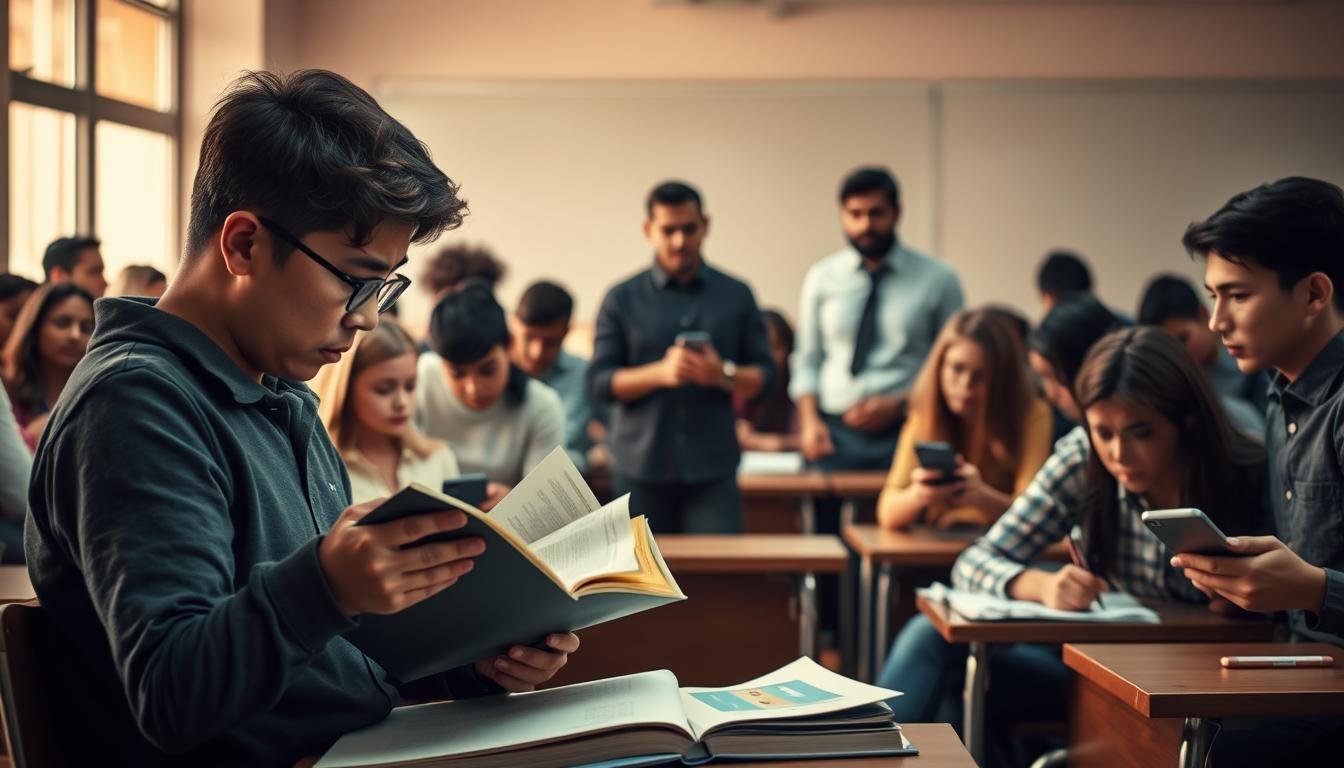Education systems today face a growing challenge: keeping students engaged and motivated. Many factors contribute to this issue, from cognitive limitations to systemic barriers. Understanding these elements is crucial for creating effective learning environments.
Research shows that working memory limitations can hinder information retention. Microsoft’s studies reveal that attention spans have shrunk to just eight seconds, impacting classroom engagement. Additionally, sleep deprivation affects 70% of Australian teens, further reducing their ability to perform well in school.
Systemic issues, such as curriculum relevance and representation gaps, also play a role. These factors can make students feel disconnected from their education. Addressing these challenges requires a holistic approach, focusing on both cognitive and environmental factors.
Key Takeaways
- Working memory limitations affect information retention.
- Attention spans are shorter, impacting classroom engagement.
- Sleep deprivation significantly affects academic performance.
- Curriculum relevance and representation gaps can lead to disengagement.
- A holistic approach is needed to address these challenges.
Introduction: The Growing Discontent with School
In recent years, dissatisfaction with school has become a global concern. A Microsoft study reveals that human attention spans have dropped to just eight seconds, a 25% decrease over the past decade. This shift impacts how students engage with lessons, making traditional teaching methods less effective.
Visual learning has emerged as a powerful alternative. Research from Videoscribe shows that visual instruction boosts effectiveness by 83% compared to text-only methods. This highlights the need for innovative approaches to keep students engaged.
The pandemic has worsened existing challenges. Many students experienced significant learning loss during this period, further widening the gap in academic achievement. Addressing these issues requires a focus on both cognitive and emotional well-being.
Studies suggest that “school liking” is a strong predictor of academic success. When students feel connected to their learning environment, they perform better. However, factors like sleep deprivation can hinder this connection. Australian teens, for example, rank as the third most sleep-deprived in the world.
Schools like Mooroopna Park Primary are leading the way with holistic support models. By integrating therapists and nutritionists, they address both mental and physical health, creating a more supportive environment for students.
Academic Struggles and Learning Challenges
Academic challenges often stem from mismatched learning methods and student needs. Many students find schoolwork overwhelming due to cognitive limitations and environmental factors. Understanding these issues is key to creating effective solutions.
Cognitive load theory explains why students struggle with complex tasks. Working memory can only handle about four chunks of information at a time. When lessons exceed this limit, students feel overwhelmed and disengaged.
Traditional methods like rote memorization often fail to engage learners. In contrast, project-based learning encourages critical thinking and creativity. This approach helps students apply their skills in real-world scenarios, making learning more meaningful.
Schools like Kids R Kids are adopting multimodal teaching strategies. These methods cater to different learning styles, ensuring every student can thrive. By combining visual, auditory, and hands-on activities, teachers create a more inclusive classroom environment.
Homework is another common pain point. A study found that 68% of students feel assignments are either too easy or too hard. This mismatch can lead to frustration and disengagement. Tailoring homework to individual needs can help bridge this gap.
Emerging technologies like VR and AR are transforming STEM education. These tools reduce distractions and make complex concepts easier to grasp. By integrating technology, teachers can create more engaging and effective lessons.
The Pressure to Perform: Grades and Expectations
The pursuit of academic excellence often comes with immense pressure. Students face high expectations from parents and teachers, which can lead to stress and anxiety. This focus on performance metrics can overshadow the joy of learning, creating a challenging environment for many learners.
Parental and Teacher Expectations
High expectations from parents and educators can weigh heavily on students. Many feel the need to meet these standards to gain approval or avoid disappointment. This pressure often starts early, with grades becoming a primary measure of success.
Research from the Black School Psychologists Network highlights the impact of curriculum representation gaps. When students don’t see themselves reflected in their studies, they may feel disconnected. This adds another layer of stress, making it harder to meet expectations.
The Stress of Standardized Testing
Standardized testing is a major source of anxiety for students. Weeks leading up to these exams often see spikes in cortisol levels, a stress hormone. This physiological response can negatively impact performance and well-being.
Internationally, testing systems like PISA and NAEP differ in their pressure levels. Some school districts are taking steps to reduce this burden. For example, one district eliminated letter grades below 8th grade, focusing instead on skill development.
Tools like Mind Brain Emotion skill-building cards are helping students manage stress. These resources teach coping strategies, making it easier to navigate high-pressure situations. By addressing both academic and emotional needs, schools can create a more supportive environment.
Social Dynamics: Friendships and Peer Pressure
Navigating social dynamics in school can shape a child’s experience significantly. Friendships and peer interactions are central to their development, influencing how they perceive themselves and others. However, these relationships can also bring challenges, such as peer pressure and bullying.
The Ups and Downs of Making Friends
Building friendships is a key part of a child’s social journey. From kindergarten to high school, students experience milestones in their relationships. Early friendships often revolve around shared activities, while older students seek deeper connections based on common interests.
However, making friends isn’t always easy. Some children struggle with shyness or finding common ground with peers. Schools like Mooroopna Park Primary integrate play therapy to help students develop social skills in a supportive environment.
Bullying and Its Emotional Toll
Bullying remains a significant issue in schools, affecting students’ emotional well-being and academic performance. Research from the Black School Psychologists Network shows that 23% of bullied students experience decreased ethnic identity perception. This can lead to feelings of isolation and disconnection.
Cyberbullying has added a new layer of complexity. Unlike traditional schoolyard bullying, it can happen 24/7, making it harder for students to escape. NIH data reveals that bullied students’ GPAs are, on average, 0.5 points lower than their peers.
Recognizing the signs of bullying is crucial. Pediatricians recommend looking for physical or behavioral changes, such as unexplained injuries, withdrawal, or sudden changes in mood. Schools with anti-bullying protocols, like Mooroopna Park, often integrate play therapy to address these issues effectively.
Why Do Kids Hate School? The Role of Teachers
Teachers play a pivotal role in shaping a student’s educational journey. Their methods and relationships with students can either foster engagement or lead to disconnection. Understanding how teaching styles and classroom dynamics impact learning is essential for creating effective educational environments.
Mismatch Between Teaching and Learning Styles
One common issue is the mismatch between teaching methods and student needs. Traditional lecture-based approaches often fail to hold students’ attention. Research shows that flipped classrooms, where students engage with material before class, improve knowledge retention by 20% compared to lectures.
Pearson’s research highlights the importance of accommodating neurodiversity in teaching. By tailoring lessons to different learning styles, teachers can create a more inclusive environment. For example, New York’s $200M teacher training initiative focuses on cultural competency, ensuring educators can connect with diverse student populations.
The Importance of Teacher-Student Relationships
Strong bonds between teachers and students are crucial for academic success. A longitudinal study found that positive relationships reduce dropout rates by 31%. When students feel supported, they are more likely to engage and perform well.
Special education inclusion models in Midwest schools demonstrate the way tailored support can transform outcomes. Similarly, Singapore’s requirement of 100 hours of annual teacher development ensures educators stay equipped to meet evolving student needs.
By focusing on both teaching methods and relationships, schools can create environments where every class thrives. This holistic approach ensures that students feel valued and motivated to learn.
The Overload of Information and Memory Limits
The brain has its limits when it comes to processing and retaining information. Cognitive science shows that working memory can only handle about four chunks of information at a time. When lessons exceed this capacity, students often feel overwhelmed and struggle to keep up.
How Working Memory Affects Learning
Working memory plays a crucial role in how students absorb and apply new knowledge. According to cognitive load theory, overloading this system can hinder learning. For example, a case study in Denver schools found that chunking lessons into smaller, manageable parts improved retention by 25%.
Spaced repetition is another effective strategy. Research shows that students retain 50% more information after 30 days compared to cramming. This approach aligns with the Atkinson-Shiffrin memory model, which emphasizes the importance of repetition and retrieval.
The Challenge of Retaining Information
Retaining information is a daily struggle for many students. PISA data reveals that countries with high content volumes often see lower national scores. This highlights the need for curriculum redesign to prioritize quality over quantity.
Schools across the U.S. are adopting tools like the Cornell Note-Taking System to help students organize and retain information. Over 1,200 schools have implemented this method, reporting significant improvements in academic performance.
By understanding the science behind memory and applying these strategies, educators can create more effective learning environments. This ensures that students can focus on mastering essential things without feeling overwhelmed.
Lack of Sleep and Its Impact on School Performance
Sleep plays a critical role in academic success, yet many students struggle to get enough rest. Research shows that 70% of Australian high school students are regularly sleep-deprived. This lack of sleep affects their ability to focus, retain information, and perform well in school.
The Connection Between Sleep and Learning
Quality sleep is essential for cognitive functions like memory and problem-solving. Studies reveal that teens need 8-10 hours of sleep each night for optimal health and learning. However, circadian rhythms often shift during adolescence, making early morning starts challenging.
Data from the National Sleep Foundation suggests that schools should start no earlier than 8:30 AM to align with teen sleep patterns. Schools in Connecticut have implemented “Sleep Hygiene” modules to educate students about the importance of a consistent routine and avoiding screens before bed.
How Schools Can Promote Healthy Sleep Habits
Schools play a key role in fostering better sleep habits. One effective strategy is integrating blue light filters into 1:1 device programs. This reduces exposure to sleep-disrupting light, helping students wind down at home.
Internationally, countries like Finland and South Korea have adjusted school schedules to prioritize student well-being. In the U.S., some districts are exploring later start times and providing FDA-approved sleep apps to help teens track their sleep patterns.
By addressing sleep deprivation through education and policy changes, schools can create environments where students thrive academically and emotionally.
The Classroom Environment: Engagement and Boredom
The industrial-era classroom model no longer meets the needs of today’s learners. Traditional setups, designed for rote memorization, often fail to capture students’ attention. This disconnect leads to boredom and disengagement, making it harder for students to retain information.
Why Traditional Lessons Fall Short
Many classroom environments still rely on outdated methods. Lectures and textbooks dominate, leaving little room for interactive or hands-on learning. Research shows that students retain only 10% of information from lectures, compared to 75% from active participation.
ISTE standards highlight the need for technology integration to improve engagement. Schools that adopt these standards see a 22% boost in student participation. For example, Arizona’s AI-powered adaptive learning platform has transformed STEM education by personalizing lessons to individual needs.
The Role of Technology in Modern Classrooms
Emerging tools like VR and AR are reshaping the classroom experience. Pilot programs report a 22% increase in engagement when these technologies are used. Gamification, another innovative approach, has raised STEM course completion rates by 15% in some districts.
Singapore’s “Future Classroom” project showcases the potential of IoT integration. Smartboards, real-time data analytics, and collaborative tools create dynamic learning environments. These advancements ensure students stay engaged and motivated during lessons.
By embracing modern technology, schools can bridge the gap between traditional methods and 21st-century learning. This shift not only improves engagement but also prepares students for the challenges of the future.
Emotional and Mental Health Challenges
Mental health challenges among students have reached alarming levels in recent years. The CDC reports a 44% increase in adolescent depression rates since 2010. This rise highlights the need for schools to address emotional well-being alongside academic performance.
Anxiety and Depression in School-Aged Kids
Anxiety and depression are among the most common mental health issues faced by students. The pandemic exacerbated these challenges, with a 37% rise in school refusal cases. Many students struggle to cope with the pressure of academic expectations and social dynamics.
California has taken a proactive approach with a $4.7 billion initiative to support student mental health. Programs like Social and Emotional Learning (SEL) have shown promising results, with an 11% improvement in GPAs in Title I schools. These efforts aim to create a more supportive environment for students.
The Importance of Emotional Support
Emotional support from family and educators plays a crucial role in addressing mental health issues. Cognitive Behavioral Therapy (CBT) and Dialectical Behavior Therapy (DBT) are effective tools in school-based counseling. NAMI’s mental health first aid training equips staff to identify and respond to student needs.
Schools that prioritize emotional well-being see fewer behavioral issues and better academic outcomes. By fostering a culture of care, educators can help students navigate challenging days and build resilience for the future.
Conclusion: Helping Kids Rediscover the Joy of Learning
Reimagining education starts with understanding what truly engages young minds. OECD data shows that holistic education models outperform traditional systems, emphasizing emotional and cognitive growth. By integrating these approaches, schools can create environments where kids thrive.
A 5-point action plan for parents and educators includes fostering collaboration, prioritizing mental health, and embracing innovative teaching methods. Finland’s phenomenon-based learning system, for example, has shown remarkable success in boosting student engagement and creativity.
Khan Academy’s mastery learning system is another example, with adoption rates increasing globally. This approach ensures students grasp concepts before moving forward, reducing frustration and building confidence.
UNESCO’s 2030 inclusive education framework highlights the importance of creating equitable school environments. By focusing on accessibility and diversity, we can ensure every child feels valued and supported in their learning journey.
Together, these strategies can help kids rediscover the joy of education, preparing them for a brighter future in an ever-changing world.
FAQ
What makes schoolwork overwhelming for students?
Schoolwork can feel overwhelming due to the volume of assignments, tight deadlines, and difficulty understanding certain subjects. Without proper support, students may struggle to keep up with the pace of lessons.
How do parental and teacher expectations affect students?
High expectations from parents and teachers can create stress and anxiety. Students may feel pressured to achieve perfect grades, which can lead to burnout and a negative attitude toward learning.
How does bullying impact a child’s experience at school?
Bullying can cause emotional distress, lower self-esteem, and make students dread attending. It creates a hostile environment that interferes with their ability to focus and enjoy the learning process.
Why is the teacher-student relationship important?
A positive teacher-student relationship fosters trust and motivation. When students feel understood and supported, they are more likely to engage in lessons and perform better academically.
How does lack of sleep affect school performance?
Insufficient sleep impairs concentration, memory, and problem-solving skills. Students who are sleep-deprived often struggle to stay alert and retain information during class.
Why do traditional lessons fail to engage students?
Traditional lessons often rely on repetitive methods that don’t cater to diverse learning styles. This can lead to boredom and disengagement, making it harder for students to stay interested.
What role does technology play in modern classrooms?
Technology can enhance learning by providing interactive tools and resources. However, over-reliance on screens without proper guidance can also distract students and reduce focus.
How can schools support students’ emotional health?
Schools can offer counseling services, create safe spaces for expression, and train staff to recognize signs of anxiety or depression. Emotional support helps students feel valued and understood.









